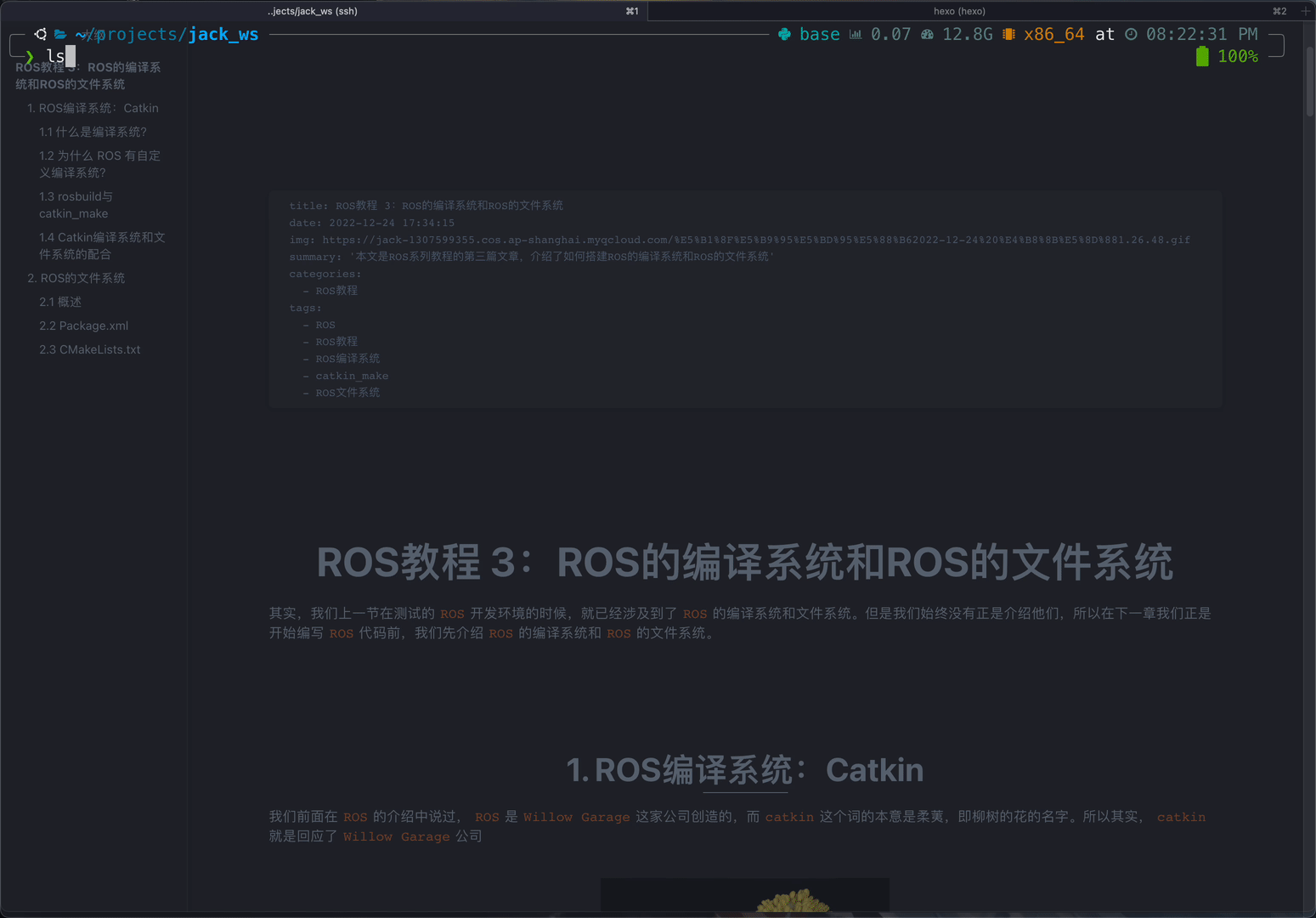
ROS1教程 3:ROS1的编译系统和ROS1的文件系统
其实,我们上一节在测试的ROS1开发环境的时候,就已经涉及到了ROS1的编译系统和文件系统。但是我们始终没有正是介绍他们,所以在下一章我们正是开始编写ROS1代码前,我们先介绍ROS1的编译系统和ROS1的文件系统。
1. ROS1编译系统:Catkin
我们前面在ROS1的介绍中说过,ROS1是Willow Garage这家公司创造的,而catkin这个词的本意是柔荑,即柳树的花的名字。所以其实,catkin就是回应了Willow Garage公司

1.1 什么是编译系统?
编译系统负责编译源代码,生成最终的目标。目标可以是库、可执行程序、(自动生成的)脚本、(自动导出的)接口(例如 C++ 头文件)或任何其他非静态代码的形式。
在软件开发中广泛使用的流行编译系统包括:
- GNU Make
- GNU Autotools
- CMake
- Apache Ant(主要用于 Java)
此外,还有Google的Bazel、微软的Visual Build等等。
几乎所有集成开发环境,例如Qt Creator、Microsoft Visual Studio和Eclipse,都为它们支持的相应语言创造了自己的编译系统,例如QMake和Visual Build。这些 IDE 中的编译系统通常都是给其他的编译系统进行了包装,例如:Autotools、CMake。即QMake和Visual Build都是Autotools和Cmake的前端。
要构建目标,编译系统需要一套工具,即工具链,包括:C++编译器、链接器等等。而除了这些工具以外,编译系统还需要这些工具的其他信息,例如工具的位置、源代码的位置、代码依赖项、外部依赖项、这些依赖项位于何处、要编译哪些目标、生成的编译目标的位置等信息,以及它们应该安装的位置……
这些信息通常保存在一个文件之后,而后在调用编译系统编译的时候,编译系统会读取的文件中的内容,而后按照文件中的规矩进行编译。这个文件称为配置文件。例如CMake中,它的配置文件通常命名为CMakeLists.txt,而GNU Make,它的配置文件通常命名为Makefile。而在IDE中,则通常把配置文件中的信息存储为工作区/项目的元信息,例如Visual C++项目文件的一部分。
类似的,ROS1使用自定义构建系统catkin,它是基于CMake的构建系统,以管理包之间的依赖关系。
1.2 为什么 ROS1 有自定义编译系统?
对于单个软件项目的开发,Autotools、CMake等现有编译系统往往就够用了。然而,这些工具虽然可以胜任大型、复杂、高度异构(包含多种语言写成的代码)的项目的编译,但是往往可能需要复杂的配置,因为特定目标可能具有大量的依赖项。
例如项目可能需要分别编译
C/C++代码和rust代码,然后运行的时候又需要先运行Python脚本启动客户端去链接Java代码写的服务器……
如此复杂的项目中具有大量特定的链接方式、自定义的构建规则和运行规则,但是Autotools和CMake是面向通用项目的。因此需要在Autotools和CMake的配置文件中需要进行大量的设置才能够编译复杂的项目,因此没有软件开发背景的人也往往难以实现。
而ROS1恰巧正如上面所说,ROS1是一个非常大的松散联合包集合。不同的包之间可能是用不同的语言写成的,各自都有不同的依赖、开发工具工具和代码组织约定。因此,某些包中目标的编译过程可能与另一个的编译方式完全不同。例如A公司的机器人的机械臂的代码使用CMake去编译代码,而B公司的地盘的代码使用Autotools编译。
因此,为了屏蔽包与包之间的编译的差异,ROS1提供了一个更加高层的编译系统,即catkin编译系统。具体来说,catkin对CMake进行了扩展,为其添加了很多的扩展配置,例如专门用于ROS1的CMake函数等等。所以换句话说,catkin都旨在通过使用工具和约定来简化ROS1的编译过程,从而使得编译和运行ROS1代码变得更加容易。没有它,有效地共享ROS1的代码将更加困难。
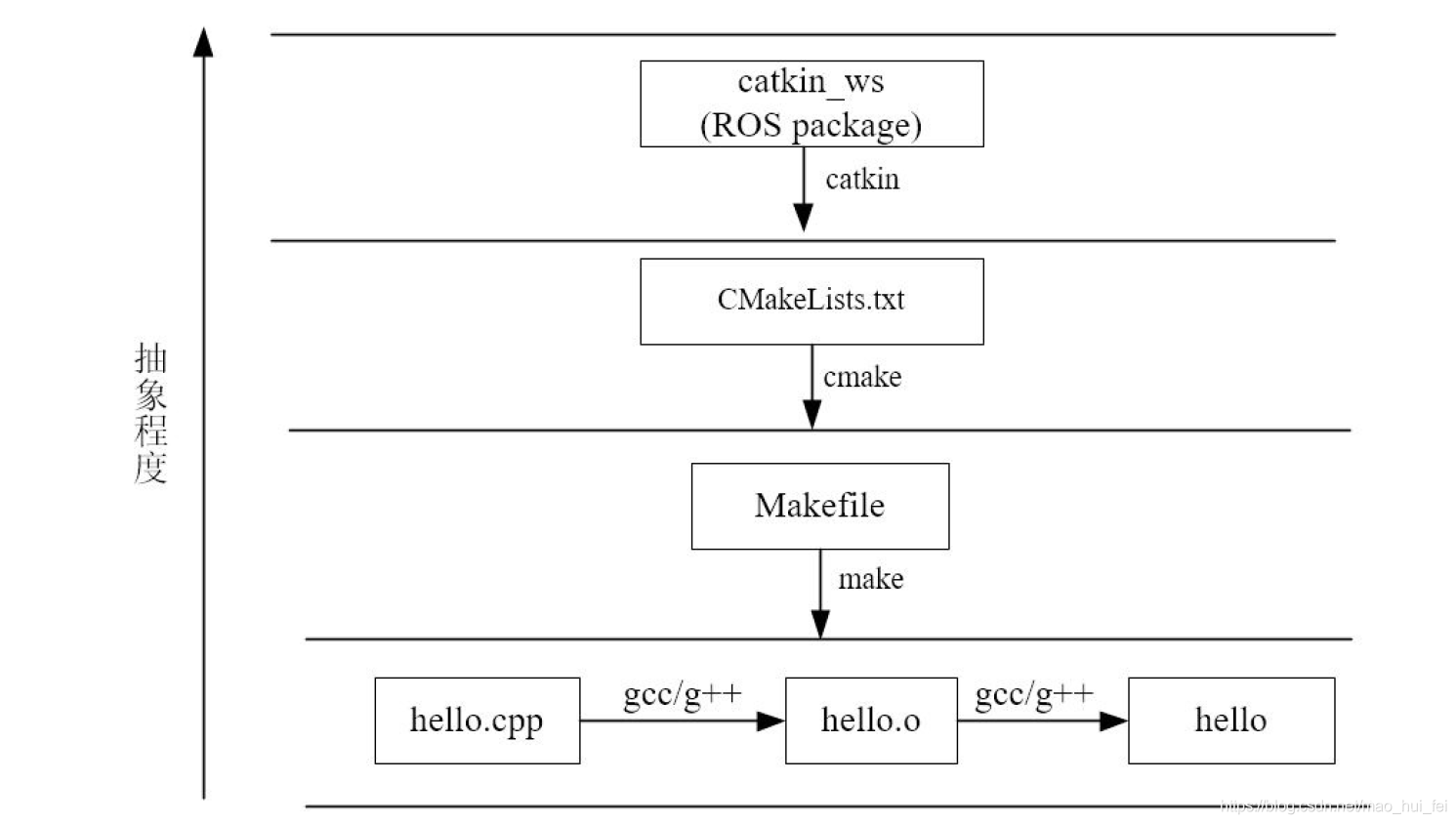
1.3 rosbuild与catkin_make
事实上,ROS1最初的编译系统是rosbuild,后来才换成了catkin
因为在ROS1的早期版本中,rosbuild作为ROS1的编译系统运行良好。但随着ROS1代码库的快速增长以及多年的运用已经暴露出rosbuild设计时的一些缺点,因此catkin试图弥补这些缺点。
举一个例子,rosbuild的最大问题之一是它不能轻松的移植到所有操作系统,尤其是Windows。这是因为rosbuild混合使用Bash脚本、GNU Make和 CMake来构建代码。在rosbuild中,当我们调用编译系统时,我们必须调用 rosbuild 提供的自定义脚本,例如rosmake。rosmake是一个调用make的 Bash 脚本,它本身调用 CMake,CMake 生成另一个 makefile,最后再次调用make。属实是太不优雅了。而catkin更优雅,只需调用 CMake 即可完成编译。
Catkin 中自定义非常多的 CMake 宏以及一些Python代码实现的。由于CMake和Python都是多平台通用的,因此catkin可以轻松移植到任何同时支持Python和CMake的系统。事实上,catkin 项目以与其他 CMake 项目无缝使用——构建 catkin 项目时,它们还会生成导出信息,允许在别的CMake项目中使用CMake的函数 find_package()函数找到它们。
除了复杂的编译流程外,还有:次优的设计决策、黑客攻击和不必要的复杂性等等问题,因此这些问题促使ROS1替换掉rosbuild。
1.4 Catkin编译系统和文件系统的配合
一个复杂的项目需要很好的文件结构规划,而ROS1中catkin编译系统能够很好的和ROS1的文件系统配合。
2. ROS1的文件系统
所谓文件系统,指的是文件在硬盘上的存储方式。因此ROS1的文件系统指的就是硬盘上ROS1源代码的组织形式,其结构大致可以如下图所示:
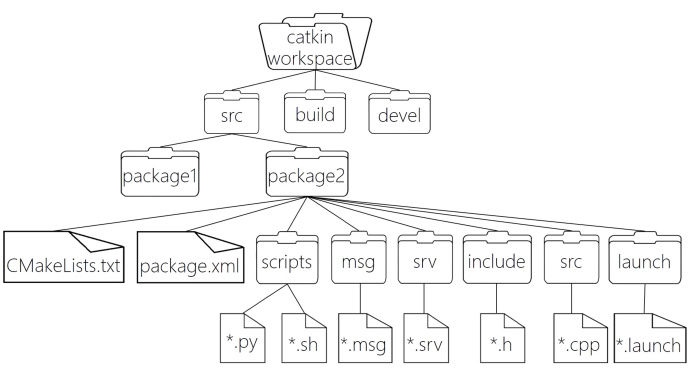
2.1 概述
ROS1文件系统中各个文件的作用的解释如下:
WorkSpace --- 自定义的工作空间
|--- build:编译空间,用于存放CMake和catkin的缓存信息、配置信息和其他中间文件。
|--- devel:开发空间,用于存放编译后生成的目标文件,包括头文件、动态&静态链接库、可执行文件等。
|--- src: 源码
|-- package:功能包(ROS1基本单元)包含多个节点、库与配置文件,包名所有字母小写,只能由字母、数字与下划线组成
|-- CMakeLists.txt 配置编译规则,比如源文件、依赖项、目标文件
|-- package.xml 包信息,比如:包名、版本、作者、依赖项...(以前版本是 manifest.xml)
|-- scripts 存储python文件
|-- src 存储C++源文件
|-- include 头文件
|-- msg 消息通信格式文件
|-- srv 服务通信格式文件
|-- action 动作格式文件
|-- launch 可一次性运行多个节点
|-- config 配置信息
|-- CMakeLists.txt: 编译的基本配置
ROS1 文件系统中各个目录下的内容后面教程会逐一进行介绍,目前我们主要介绍:package.xml与CMakeLists.txt这两个配置文件。
2.2 Package.xml
package.xml是catkin编译系统的一部分,该文件定义了一个catkin软件包的属性,例如软件包名称,版本号,作者,维护者以及对其他catkin软件包的依赖性。请注意,该概念类似于旧版 rosbuild 构建系统中使用的manifest.xml文件。
对一个标准的package.xml的注释如下
<?xml version="1.0"?>
<!-- 格式: 以前是 1,推荐使用格式 2 -->
<package format="2">
<!-- 包名 -->
<name>example</name>
<!-- 版本 -->
<version>0.0.1</version>
<!-- 描述信息 -->
<description>Example of package.xml</description>
<!-- One maintainer tag required, multiple allowed, one person per tag -->
<!-- Example: -->
<!-- <maintainer email="jane.doe@example.com">Jane Doe</maintainer> -->
<!-- 维护人员 -->
<maintainer email="jack3shihong@gmail.com">jackwang</maintainer>
<!-- One license tag required, multiple allowed, one license per tag -->
<!-- Commonly used license strings: -->
<!-- BSD, MIT, Boost Software License, GPLv2, GPLv3, LGPLv2.1, LGPLv3 -->
<!-- 许可证信息,ROS1核心组件默认 BSD -->
<license>BSD</license>
<!-- Url tags are optional, but multiple are allowed, one per tag -->
<!-- Optional attribute type can be: website, bugtracker, or repository -->
<!-- Example: -->
<!-- <url type="website">http://wiki.ROS1.org/demo01_hello_vscode</url> -->
<!-- Author tags are optional, multiple are allowed, one per tag -->
<!-- Authors do not have to be maintainers, but could be -->
<!-- Example: -->
<!-- <author email="jane.doe@example.com">Jane Doe</author> -->
<!-- The *depend tags are used to specify dependencies -->
<!-- Dependencies can be catkin packages or system dependencies -->
<!-- Examples: -->
<!-- Use depend as a shortcut for packages that are both build and exec dependencies -->
<!-- <depend>roscpp</depend> -->
<!-- Note that this is equivalent to the following: -->
<!-- <build_depend>roscpp</build_depend> -->
<!-- <exec_depend>roscpp</exec_depend> -->
<!-- Use build_depend for packages you need at compile time: -->
<!-- <build_depend>message_generation</build_depend> -->
<!-- Use build_export_depend for packages you need in order to build against this package: -->
<!-- <build_export_depend>message_generation</build_export_depend> -->
<!-- Use buildtool_depend for build tool packages: -->
<!-- <buildtool_depend>catkin</buildtool_depend> -->
<!-- Use exec_depend for packages you need at runtime: -->
<!-- <exec_depend>message_runtime</exec_depend> -->
<!-- Use test_depend for packages you need only for testing: -->
<!-- <test_depend>gtest</test_depend> -->
<!-- Use doc_depend for packages you need only for building documentation: -->
<!-- <doc_depend>doxygen</doc_depend> -->
<!-- 依赖的构建工具,这是必须的 -->
<buildtool_depend>catkin</buildtool_depend>
<!-- 指定构建此软件包所需的软件包 -->
<build_depend>roscpp</build_depend>
<build_depend>rospy</build_depend>
<build_depend>std_msgs</build_depend>
<!-- 指定根据这个包构建库所需要的包 -->
<build_export_depend>roscpp</build_export_depend>
<build_export_depend>rospy</build_export_depend>
<build_export_depend>std_msgs</build_export_depend>
<!-- 运行该程序包中的代码所需的程序包 -->
<exec_depend>roscpp</exec_depend>
<exec_depend>rospy</exec_depend>
<exec_depend>std_msgs</exec_depend>
<!-- The export tag contains other, unspecified, tags -->
<export>
<!-- Other tools can request additional information be placed here -->
</export>
</package>
2.3 CMakeLists.txt
CMakeLists.txt是CMake构建系统的输入,用于构建软件包。任何兼容CMake的软件包都包含一个或多个CMakeLists.txt文件,这些文件描述了如何构建代码以及将代码安装到何处。
我们前面说到,catkin是给CMake做了扩展,添加了ROS1专用的函数,因此ROS1文件系统中需要有一个CMakeLists.txt,而catkin编译的时候会调用CMake去读取CMakeLists.txt中的数据
下面是一个包中的CMakeLists.txt的内容:
make_minimum_required(VERSION 3.0.2) #所需 cmake 版本
project(example) #包名称,会被 ${PROJECT_NAME} 的方式调用
## Compile as C++11, supported in ROS1 Kinetic and newer
# add_compile_options(-std=c++11)
## Find catkin macros and libraries
## if COMPONENTS list like find_package(catkin REQUIRED COMPONENTS xyz)
## is used, also find other catkin packages
#设置构建所需要的软件包
find_package(catkin REQUIRED COMPONENTS
roscpp
rospy
std_msgs
)
## System dependencies are found with CMake's conventions
#默认添加系统依赖
# find_package(Boost REQUIRED COMPONENTS system)
## Uncomment this if the package has a setup.py. This macro ensures
## modules and global scripts declared therein get installed
## See http://ROS1.org/doc/api/catkin/html/user_guide/setup_dot_py.html
# 启动 python 模块支持
# catkin_python_setup()
################################################
## Declare ROS1 messages, services and actions ##
## 声明 ROS1 消息、服务、动作... ##
################################################
## To declare and build messages, services or actions from within this
## package, follow these steps:
## * Let MSG_DEP_SET be the set of packages whose message types you use in
## your messages/services/actions (e.g. std_msgs, actionlib_msgs, ...).
## * In the file package.xml:
## * add a build_depend tag for "message_generation"
## * add a build_depend and a exec_depend tag for each package in MSG_DEP_SET
## * If MSG_DEP_SET isn't empty the following dependency has been pulled in
## but can be declared for certainty nonetheless:
## * add a exec_depend tag for "message_runtime"
## * In this file (CMakeLists.txt):
## * add "message_generation" and every package in MSG_DEP_SET to
## find_package(catkin REQUIRED COMPONENTS ...)
## * add "message_runtime" and every package in MSG_DEP_SET to
## catkin_package(CATKIN_DEPENDS ...)
## * uncomment the add_*_files sections below as needed
## and list every .msg/.srv/.action file to be processed
## * uncomment the generate_messages entry below
## * add every package in MSG_DEP_SET to generate_messages(DEPENDENCIES ...)
## Generate messages in the 'msg' folder
# add_message_files(
# FILES
# Message1.msg
# Message2.msg
# )
## Generate services in the 'srv' folder
# add_service_files(
# FILES
# Service1.srv
# Service2.srv
# )
## Generate actions in the 'action' folder
# add_action_files(
# FILES
# Action1.action
# Action2.action
# )
## Generate added messages and services with any dependencies listed here
# 生成消息、服务时的依赖包
# generate_messages(
# DEPENDENCIES
# std_msgs
# )
################################################
## Declare ROS1 dynamic reconfigure parameters ##
## 声明 ROS1 动态参数配置 ##
################################################
## To declare and build dynamic reconfigure parameters within this
## package, follow these steps:
## * In the file package.xml:
## * add a build_depend and a exec_depend tag for "dynamic_reconfigure"
## * In this file (CMakeLists.txt):
## * add "dynamic_reconfigure" to
## find_package(catkin REQUIRED COMPONENTS ...)
## * uncomment the "generate_dynamic_reconfigure_options" section below
## and list every .cfg file to be processed
## Generate dynamic reconfigure parameters in the 'cfg' folder
# generate_dynamic_reconfigure_options(
# cfg/DynReconf1.cfg
# cfg/DynReconf2.cfg
# )
###################################
## catkin specific configuration ##
## catkin 特定配置##
###################################
## The catkin_package macro generates cmake config files for your package
## Declare things to be passed to dependent projects
## INCLUDE_DIRS: uncomment this if your package contains header files
## LIBRARIES: libraries you create in this project that dependent projects also need
## CATKIN_DEPENDS: catkin_packages dependent projects also need
## DEPENDS: system dependencies of this project that dependent projects also need
# 运行时依赖
catkin_package(
# INCLUDE_DIRS include
# LIBRARIES demo01_hello_vscode
# CATKIN_DEPENDS roscpp rospy std_msgs
# DEPENDS system_lib
)
###########
## Build ##
###########
## Specify additional locations of header files
## Your package locations should be listed before other locations
# 添加头文件路径,当前程序包的头文件路径位于其他文件路径之前
include_directories(
# include
${catkin_INCLUDE_DIRS}
)
## Declare a C++ library
# 声明 C++ 库
# add_library(${PROJECT_NAME}
# src/${PROJECT_NAME}/demo01_hello_vscode.cpp
# )
## Add cmake target dependencies of the library
## as an example, code may need to be generated before libraries
## either from message generation or dynamic reconfigure
# 添加库的 cmake 目标依赖
# add_dependencies(${PROJECT_NAME} ${${PROJECT_NAME}_EXPORTED_TARGETS} ${catkin_EXPORTED_TARGETS})
## Declare a C++ executable
## With catkin_make all packages are built within a single CMake context
## The recommended prefix ensures that target names across packages don't collide
# 声明 C++ 可执行文件
add_executable(Test src/test.cpp)
## Rename C++ executable without prefix
## The above recommended prefix causes long target names, the following renames the
## target back to the shorter version for ease of user use
## e.g. "rosrun someones_pkg node" instead of "rosrun someones_pkg someones_pkg_node"
#重命名c++可执行文件
# set_target_properties(${PROJECT_NAME}_node PROPERTIES OUTPUT_NAME node PREFIX "")
## Add cmake target dependencies of the executable
## same as for the library above
#添加可执行文件的 cmake 目标依赖
add_dependencies(Test ${${PROJECT_NAME}_EXPORTED_TARGETS} ${catkin_EXPORTED_TARGETS})
## Specify libraries to link a library or executable target against
#指定库、可执行文件的链接库
target_link_libraries(Test
${catkin_LIBRARIES}
)
#############
## Install ##
## 安装 ##
#############
# all install targets should use catkin DESTINATION variables
# See http://ROS1.org/doc/api/catkin/html/adv_user_guide/variables.html
## Mark executable scripts (Python etc.) for installation
## in contrast to setup.py, you can choose the destination
#设置用于安装的可执行脚本
catkin_install_python(PROGRAMS
scripts/test.py
DESTINATION ${CATKIN_PACKAGE_BIN_DESTINATION}
)
## Mark executables for installation
## See http://docs.ROS1.org/melodic/api/catkin/html/howto/format1/building_executables.html
# install(TARGETS ${PROJECT_NAME}_node
# RUNTIME DESTINATION ${CATKIN_PACKAGE_BIN_DESTINATION}
# )
## Mark libraries for installation
## See http://docs.ROS1.org/melodic/api/catkin/html/howto/format1/building_libraries.html
# install(TARGETS ${PROJECT_NAME}
# ARCHIVE DESTINATION ${CATKIN_PACKAGE_LIB_DESTINATION}
# LIBRARY DESTINATION ${CATKIN_PACKAGE_LIB_DESTINATION}
# RUNTIME DESTINATION ${CATKIN_GLOBAL_BIN_DESTINATION}
# )
## Mark cpp header files for installation
# install(DIRECTORY include/${PROJECT_NAME}/
# DESTINATION ${CATKIN_PACKAGE_INCLUDE_DESTINATION}
# FILES_MATCHING PATTERN "*.h"
# PATTERN ".svn" EXCLUDE
# )
## Mark other files for installation (e.g. launch and bag files, etc.)
# install(FILES
# # myfile1
# # myfile2
# DESTINATION ${CATKIN_PACKAGE_SHARE_DESTINATION}
# )
#############
## Testing ##
#############
## Add gtest based cpp test target and link libraries
# catkin_add_gtest(${PROJECT_NAME}-test test/test_demo01_hello_vscode.cpp)
# if(TARGET ${PROJECT_NAME}-test)
# target_link_libraries(${PROJECT_NAME}-test ${PROJECT_NAME})
# endif()
## Add folders to be run by python nosetests
# catkin_add_nosetests(test)
2.4 ROS1文件系统常用命令
上面介绍了ROS1文件系统,下面介绍ROS1文件系统中常用的命令。事实上,ROS1其实是有一整套命令的,每个命令下其实都是有很多选项的,所有其实是有非常非常多的功能的,我们这里只是针对常用的功能来介绍某个命令中的某个选项。

A. 新增包
包可以自己创建然后自己写
catkin_create_pkg 自定义包名 依赖包
这样的话,包就会创建在当前所在的工作目录(Current Working Directory)下
此外,也可以从APT中下载,因为我们前面添加过软件源了
sudo apt install ROS1-版本号-包名
Tab补全就会显示当前版本可以安装的软件包,例如:
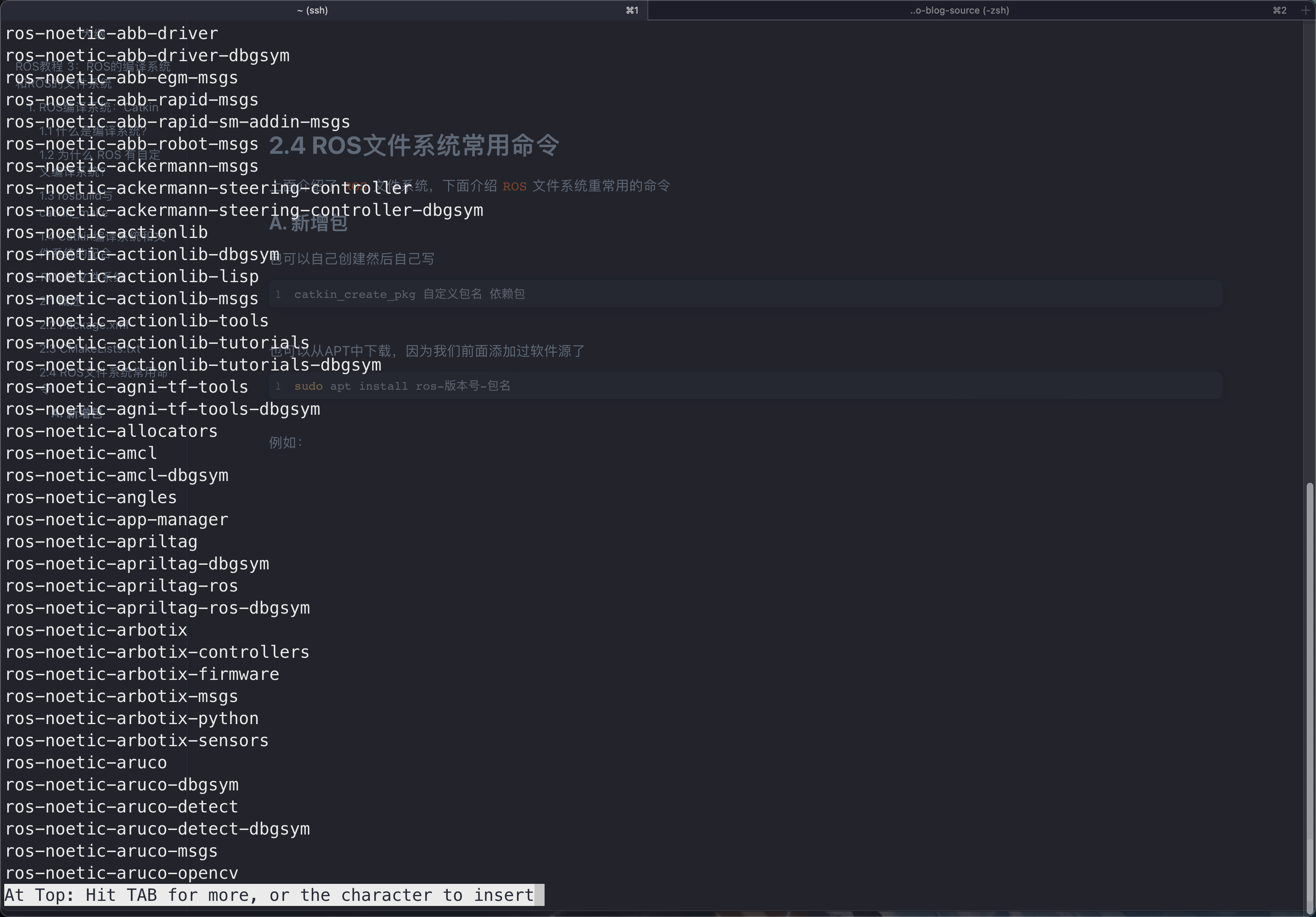
而通过APT安装的软件包,最后都会被安装到环境变量ROS_PACKAGE_PATH所表示的路径中。这个路径如果没有修改的话,默认是/opt/ROS1/noetic/share
echo $ROS_PACKAGE_PATH

B. 删除包
对于使用catkin_create_pkg创建的包,直接删除就好了,即:
cd 工作目录
rm -r src/要删除的包名
而对于APT安装的包,使用APT即可删除
sudo apt purge ROS1-版本号-包名
C. 查询包
rospack list
rospack list可以列出所有功能包
rospack list

rospack find
rospack find可以查找某个功能包是否存在,如果存在返回安装路径
rospack find 功能包名
当然rospack命令下还有很多选项,后面用到了我们再慢慢介绍
例如:
rospack find tf2

roscd
roscd可以进入某个功能包
roscd 功能包名
例如:
pwd
roscd rospy
pwd

rosls
rosl用于列出某个包下的文件
rosls 包名
例如:
rosls roscpp

apt search
我们前面说到,可以用APT直接从网上下载ROS1功能包,所以我们可以用apt search去搜索功能包
apt search ROS1-版本号-包名
例如:
sudo apt search ROS1-noetic-ROS1-py

D. 修改包
rosed可以直接修改包中的文件
rosed 功能包名 要修改的文件名
需要注意的是,rosed会调用EDITOR环境变量中表明的编辑器来打开文件
例如:
rosed rospy rospy.cmake
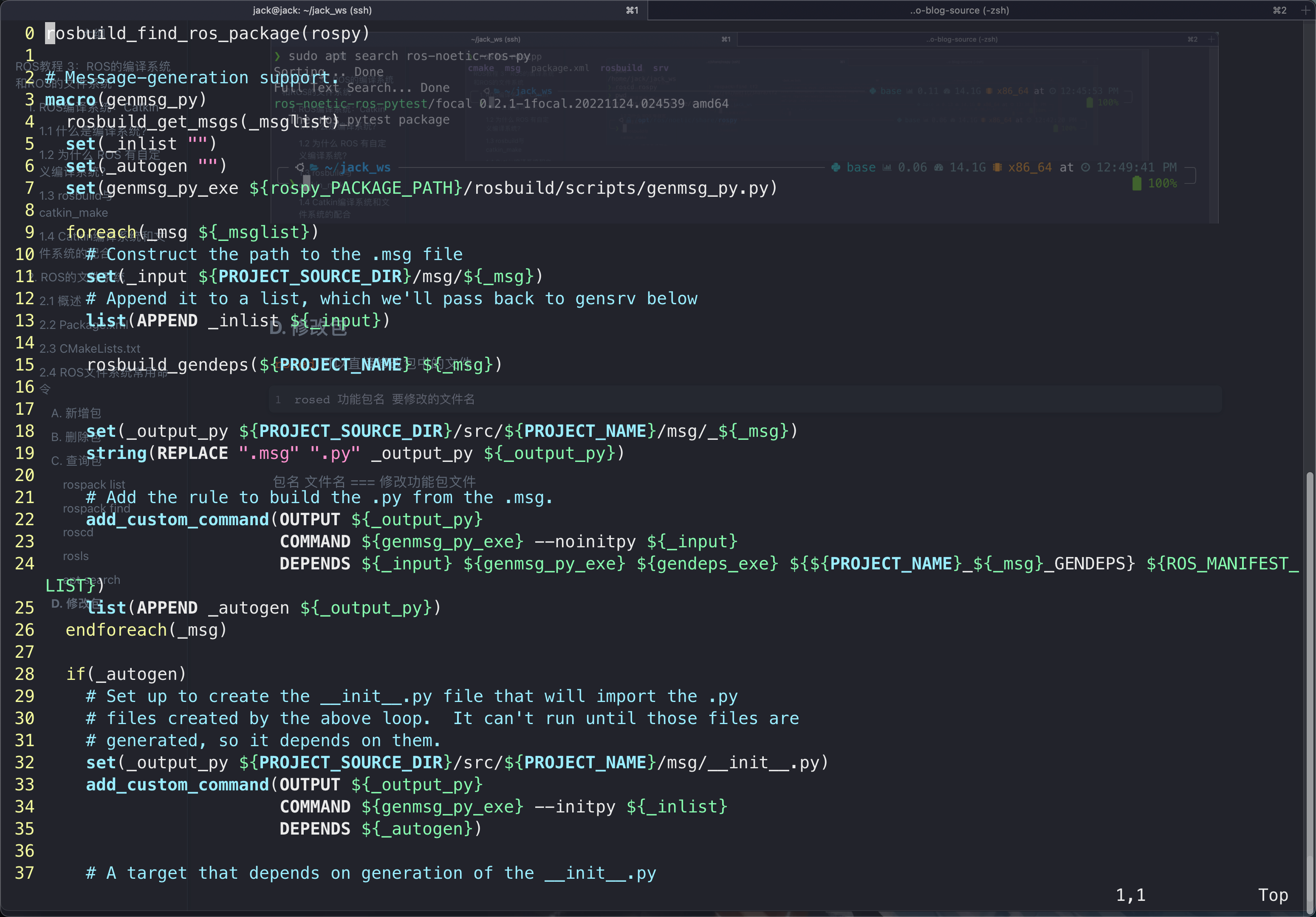
E. 运行
roscore
roscore 是 ROS1 的系统先决条件节点和程序的集合, 必须运行 roscore 才能使 ROS1 节点进行通信。
roscore 将启动:
ROS1 masterROS1参数服务器rosout日志节点
用法:
roscore
或(指定端口号)
roscore -p xxxx
rosrun
rosrun可以运行指定的ROS1节点
rosrun 功能包名 可执行文件名
例如:
rosrun turtlesim turtlesim_node

roslaunch
roslaunch用于直接执行某个包下的launch文件
roslaunch 功能包名 launch文件名



